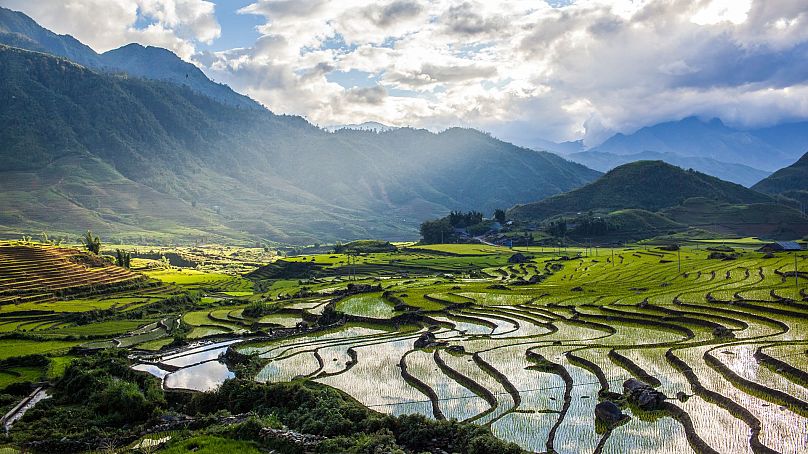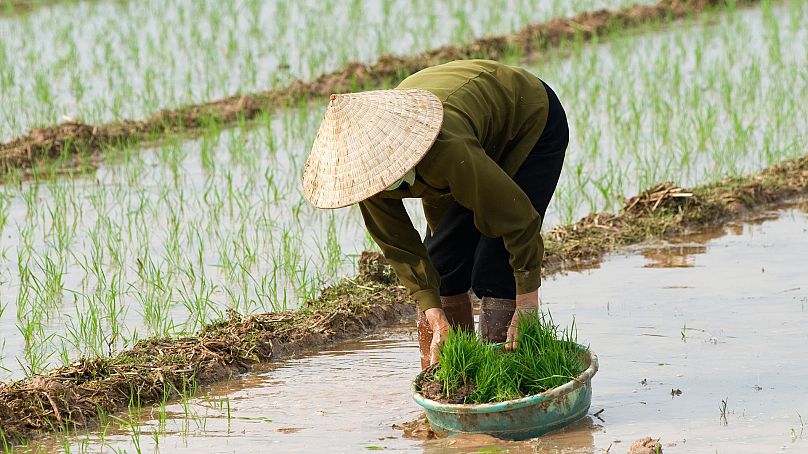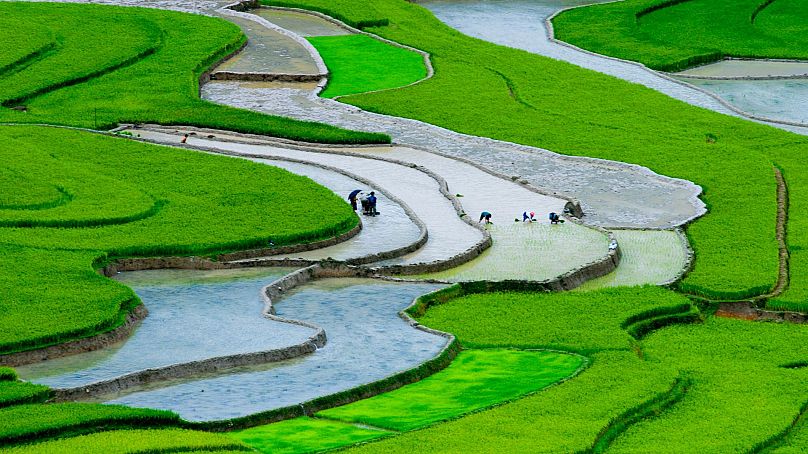Tags
Rice is a silent source of methane emissions: Meet the startup helping farmers tackle the problem

Copyright Canva
Agri-tech startup Rize is helping rice farmers In Southeast Asia to reduce their methane emissions, while giving their businesses a boost.
Rice feeds nearly half the world’s population, but the way we grow it has left a surprisingly high methane footprint.
Of the 42 per cent of global methane emissions that agriculture accounts for, eight per cent comes from rice cultivation, according to a report by the Global Climate and Health Alliance.
Farmers produce rice by flooding their paddy fields, which creates anaerobic conditions where microorganisms emit methane – a powerful greenhouse gas with 80 times the heating capacity of CO2 for the first 20 years after it is emitted.
Methane’s potency in the short term makes it a significant driver of global warming – though it also means that small wins can be made quickly if emissions are reduced.
In Indonesia, Rize is helping farmers to adopt new agricultural methods, which could cut the region’s emissions while boosting farmers’ profits.
“The idea of Rize came about because rice, second to livestock, is the largest emission issue in agriculture in Southeast Asia,” says Siem Schreurs, the startup’s partnerships lead. “The issue is easier to tackle from a rice perspective.”
Part of Rize’s strength, according to Schreurs, is its focus on working with smallholder farmers, drawing on CEO Dhruv Sawney’s past experience with ‘nurture.farm’ (an Indian sustainable agriculture app that attracted 1.5 million smallholders into its roster).
“There’s a lot of good work going through NGOs or development agencies trying to help farmers adopt new sustainable practices, but adoption rates beyond these programmes are usually very low,” says Schreurs.
“We’re really trying to get the right tech to the farmers and making sure they adopt this for longer periods of time.”

Why does rice produce so much methane?
Rice isn’t necessarily a high-emitting crop, according to Gabriel Vegh-Gaynor, who co-authored the Global Climate and Health Alliance paper on methane management.
Rather, it’s all to do with the flooding technique that has crystallised over centuries in rice paddies, and is used to deter pests and prevent weed growth from depleting soil nutrients.
“It’s a naturally occurring process when you have organic matter decomposing in low oxygen environments,” says Vegh-Gaynor. “With antigenic organisms, that’s an environment they thrive in, and they’ll produce methane under those conditions.”
Compounding the problem is the scale of rice production. More than 3.5 billion people are thought to get 20 per cent of their daily calories from rice, and demand is increasing.
But cutting this staple food would hardly be equitable. Vegh-Geynor cites Bangladesh, where nearly half of rural employment comes from rice production. “Rice contributes two thirds of all calories that folks are consuming in the country.”
There isn’t much need to halt rice’s rise through the markets, Vegh-Gaynor adds. “If you’re looking at kilocalories per emissions unit produced for that food, it’s extremely efficient,” he says. “It’s one of the most efficient foods as far as emissions go.”
Rice’s growth may even be a boon for methane reduction, as new businesses emerge to meet the world’s growing appetite.
“The opportunity lies less in the specific scale of production, but more in these new markets opening up and being able to get in at the ground floor with some alternative methods,” says Vegh-Gaynor.

How Rize reduces rice’s methane problem
Continuous flooding can be a laborious process, requiring pumps to replenish water lost to evaporation and thirsty rice plants.
But across Vietnam and Indonesia, Rize is testing a different technique with farmers called alternate wetting and drying (AWD), where paddies are allowed to dry out before more freshwater flows in.
Studies have shown that AWD reduces methane emissions by 50 per cent, which Rize hopes to enhance with further laboratory experiments.
“We can test for AWD with one drying event versus AWD with two drying events,” says Schreur. “Or we can add biochar to the soil – what would the effects be?”
The results so far are promising, with a 35 per cent drop in emissions recorded, but the true value according to Schreur is in how AWD benefits farmers.
“The root of a plant when you expose it to water stress – for example, you dry out the paddy for X amount of days – is actually growing more because it searches for more water,” he explains. “If you reapply water, then there are more roots, leading to more plant growth, leading to more yield.”
Pumping less water also means this higher crop yield is combined with energy and water savings – an appealing business proposition for the smallholder farmers Rize works with.
“It’s basically installing a pipe and ensuring there is no water in the field for some periods,” says Schreur, “so the adoption rates for these technologies are much higher.”
Rize helps farmers profit while slashing emissions
Creating a winning financial incentive, according to Schreur, is essential for retaining farmers once they have adopted AWD.
Before the start of the season, smallholder farmers must purchase essential inputs like rice seeds, fertilisers and pesticides.
“This could run up to about $600 [€550] per hectare per season,” explains Schreur. “They don’t have the liquidity to pay for it upfront, so they take out a loan with up to 10 to 15 per cent of interest costs.”
To solve this financial challenge, Rize procures those inputs in bulk, meaning the farmer can buy them at a reduced price without the additional interest.
A dedicated agronomist – an expert in crop production and soil and pest management – is then assigned to every farm to assist with the transition, overseeing the pipe installation and advising the farmer.
“At the end of the harvest the farmer will say, ‘Hey, these guys actually put their money in my ground. They had their people come and work with me through this whole process’,” says Schreur. “All the implementation needed for AWD is on our books.”
To give AWD extra staying power, Rize works with existing networks between farmers. “Farmer groups usually have a long-lasting relationship with these farmers and there’s a lot of influence from these parties,” says Schreur.
In Vietnam, he explains, farmers are often coordinated by government-appointed farmer cooperatives, who oversee the irrigation of 10 to 100 farms.
Rize organises onboarding sessions with these cooperatives, where they share the technology’s benefits. This might take place over several sessions, nurturing a lasting connection with the community.
“It’s a continuous trust-building effort from our side,” says Schreur.

How data collection can help rice farmers improve harvests
One area of rice production that holds particular promise, according to Vegh-Gaynor, is data collection, which could help farmers to improve their harvest with targeted feedback.
“We can get increased data on very regionally-specific methods, and what’s worked in those contexts, that will help others to succeed without some of the challenges of the initial adopters,” he says.
For Rize, this data supports the agronomists, who track growing conditions and water use on each farm.
“You can call it a tech-enabled agronomy model,” says Schreur. “We track all the touch points that the agronomist has with the farmer. All the data will then be captured in our platform, which will ultimately help to better decision-making.”
This data could eventually make way for more investment. By demonstrating the success of sustainable farming practices, Rize can showcase smallholders as a low risk market.
“There’s not too much data around smallholder farmers, especially not the ones that are transitioning into another practice,” says Schreur.
“All the data points we collect could be beneficial for insurance players or micro-financing institutions looking to deploy capital to smaller farmers.”
Awareness of methane emissions is growing – but supermarket brands need to get on board
Rize’s work on the ground is a good start, but it will take more joined up thinking to get to the heart of rice’s methane problem.
“We’re a small agri-tech that’s tackling a huge issue,” says Schreur. “There needs to be more force from a downstream perspective, meaning companies like FMCGs, traders, offtakers – the larger companies that are buying large volumes of rice.”
In 2021, 111 countries signed the Global Methane Pledge, committing to cut their methane emissions by 30 per cent by 2030. This heightened awareness is promising, says Schreur, but it needs to influence the brands we see on supermarket shelves.
“There’s still a huge demand for low quality, high-emitting kinds of rice,” he says. “A lot more effort needs to go in to transition the whole value chain.”
https://www.euronews.com/green/2024/07/13/rice-is-a-silent-source-of-methane-emissions-meet-the-startup-helping-farmers-tackle-the-pPublished Date: July 13, 2024






